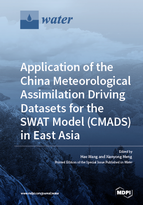Application of the China Meteorological Assimilation Driving Datasets for the SWAT Model (CMADS) in East Asia
A special issue of Water (ISSN 2073-4441). This special issue belongs to the section "Water Resources Management, Policy and Governance".
Deadline for manuscript submissions: closed (31 December 2018) | Viewed by 92929
Special Issue Editors
Interests: allocation of water resources; water resource management
Interests: atmospheric data assimilation; hydrological modeling; land surface model assimilation
Special Issues, Collections and Topics in MDPI journals
Special Issue Information
Dear Colleagues,
Due to spatial differences of climate conditions and the lack of meteorological data in East Asia, there are many challenges to conducting research on surface water in the hydrologic cycle. In addition, East Asia is facing pressure from both water resource scarcity and water pollution. The consequences of water pollution problems have been attracting public conerns in recent years. Due to the low frequencies and difficulty in monitoring non-point source pollutions, it becomes challenging to understand the continuous spatial distributions of non-point source pollution mechanisms in East Asia. China Meteorological Assimilation Driving Datasets for the SWAT model (CMADS) were developed and provided high resolution and quality meteorological data for the community. Applying CMADS can significantly reduce the meteorological input uncertainty and improve the performance of non-point source pollution modeling, since water resources and non-point source pollution can be more accurately localized. In addition, researchers can make use of high resolution time series data from CMADS for spatial and temporal scale analysis of meteorological data. Over the past few years, the CMADS data set has received worldwide attention from applicants such as the United States, Germany, Russia, Italy, India, South Korea, etc.
This Special Issue on “Application of the China Meteorological Assimilation Driving Datasets for the SWAT model (CMADS) in East Asia” invites papers that report recent advances in the modeling of water quality and quantity in watersheds using CMADS and the hydrological model on a wide range of topics. These include, but are not limited to, water resource modeling, hydrological ecology, evolution and regulation of water ecological footprint, evolution of water resources and insurance, non-point source pollution, meteorological analysis, meteorological verification, atmospheric and hydrological coupling studies, changes in water resources under climate change, optimal operational of reservoirs, water footprint assessment and water cycle in arid and cold regions. We encourage submissions based on theoretical, computational and field studies that involve multiple hydrologic domains and interactions, as well as contributions that demonstrate novel applications.
Prof. Dr. Hao Wang
Prof. Dr. Xianyong Meng
Guest Editors
Manuscript Submission Information
Manuscripts should be submitted online at www.mdpi.com by registering and logging in to this website. Once you are registered, click here to go to the submission form. Manuscripts can be submitted until the deadline. All submissions that pass pre-check are peer-reviewed. Accepted papers will be published continuously in the journal (as soon as accepted) and will be listed together on the special issue website. Research articles, review articles as well as short communications are invited. For planned papers, a title and short abstract (about 100 words) can be sent to the Editorial Office for announcement on this website.
Submitted manuscripts should not have been published previously, nor be under consideration for publication elsewhere (except conference proceedings papers). All manuscripts are thoroughly refereed through a single-blind peer-review process. A guide for authors and other relevant information for submission of manuscripts is available on the Instructions for Authors page. Water is an international peer-reviewed open access semimonthly journal published by MDPI.
Please visit the Instructions for Authors page before submitting a manuscript. The Article Processing Charge (APC) for publication in this open access journal is 2600 CHF (Swiss Francs). Submitted papers should be well formatted and use good English. Authors may use MDPI's English editing service prior to publication or during author revisions.
Keywords
- CMADS
- Climate Change
- Ecology
- Hydrology
- Meteorology
- Natural Hazard
- Pollution
- SWAT
- Sustainability







